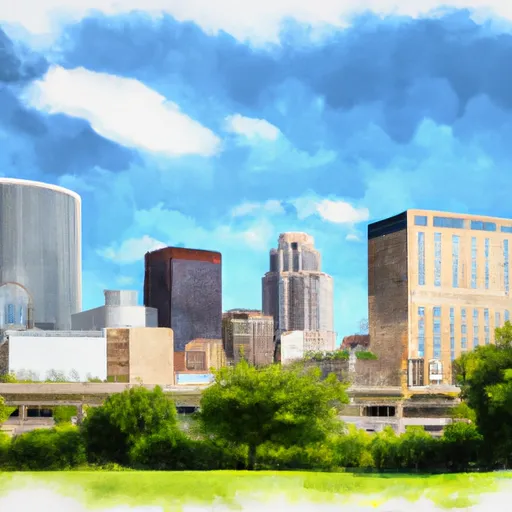-
 Snoflo Premium
Snoflo Premium
Get unlimited access to all our content
With no Ad interruptions! - Start Your Free Trial Login with existing account
Rochester
Eden Index
Climate
6.4
•
Recreation
3.2
•
Community
3.3
•
Safeguard
4.5/10

Rochester, Minnesota is a vibrant city located in the southeastern part of the state. It experiences a continental climate with four distinct seasons. Summers are warm and humid, with average temperatures ranging from the 70s to the low 80s Fahrenheit. Winters are cold and snowy, with temperatures dropping below freezing and an average snowfall of around 50 inches. Spring and autumn offer mild temperatures and beautiful foliage.
Hydrologically, Rochester is situated in the Zumbro River watershed. The Zumbro River, which flows through the city, provides opportunities for water-based activities such as fishing, boating, and kayaking. Additionally, there are several lakes in the area, including Silver Lake and Foster Arend Lake, which offer recreational opportunities like swimming and picnicking.
Outdoor enthusiasts will find plenty of recreational opportunities in and around Rochester. The city boasts an extensive network of parks and trails, including the popular Quarry Hill Nature Center, where visitors can hike, bike, and explore the limestone quarry turned nature preserve. The nearby Whitewater State Park provides additional outdoor activities such as camping, fishing, and birdwatching. With its diverse climate, hydrology constituents, and outdoor recreation opportunities, Rochester is a welcoming city for nature lovers and adventure seekers.
What is the Eden Index?
The Snoflo Eden Index serves as a comprehensive rating system for regions, evaluating their desirability through a holistic assessment of climate health, outdoor recreation opportunities, and natural disaster risk, acknowledging the profound impact of these factors on livability and well-being.
Climate Health Indicator (CHI): 6.4
Rochester receives approximately
842mm of rain per year,
with humidity levels near 83%
and air temperatures averaging around
7°C.
Rochester has a plant hardyness factor of
4, meaning
plants and agriculture in this region thrive during a short period during spring and early summer. Most
plants will die off during the colder winter months.
By considering the ideal temperature range, reliable water supplies, clean air, and stable seasonal rain or snowpacks, the Climate Health Indicator (CHI) underscores the significance of a healthy climate as the foundation for quality living.
A healthy climate is paramount for ensuring a high quality of life and livability in a region, fostering both physical well-being and environmental harmony. This can be characterized by ideal temperatures, reliable access to water supplies, clean air, and consistent seasonal rain or snowpacks.
Weather Forecast
Streamflow Conditions
Upper Mississippi-Black-Root
Area Rivers
Upper Mississippi-Black-Root
Snowpack Depths
Upper Mississippi-Black-Root
Reservoir Storage Capacity
Upper Mississippi-Black-Root
Groundwater Levels
Recreational Opportunity Index (ROI): 3.2
The Recreational Opportunity Index (ROI) recognizes the value of outdoor recreational options, such as parks, hiking trails, camping sites, and fishing spots, while acknowledging that climate plays a pivotal role in ensuring the comfort and consistency of these experiences.
Access to outdoor recreational opportunities, encompassing activities such as parks, hiking, camping, and fishing, is crucial for overall well-being, and the climate plays a pivotal role in enabling and enhancing these experiences, ensuring that individuals can engage in nature-based activities comfortably and consistently.
Camping Areas
| Campground | Campsites | Reservations | Toilets | Showers | Elevation |
|---|---|---|---|---|---|
| Lake Wapello State Park | 80 | 803 ft | |||
| Thomas Hill Reservoir - Hwy T Campground - MDC | 10 | 753 ft | |||
| Finger Lakes State Park | None | 725 ft | |||
| Drakesville City Park | 6 | 886 ft | |||
| Thousand Hills State Park | None | 862 ft | |||
| McGowen Rec Area | 12 | 857 ft | |||
| Rothwell Park | None | 858 ft | |||
| Macon Co Park | None | 873 ft | |||
| Lake Fisher | 6 | 840 ft | |||
| Long Branch State Park | None | 841 ft |
Nearby Fishing
Nearby Ski Areas
Catastrophe Safeguard Index (CSI):
The Catastrophe Safeguard Index (CSI) recognizes that natural disaster risk, encompassing floods, fires, hurricanes, and tornadoes, can drastically affect safety and the overall appeal of an area.
The level of natural disaster risk in a region significantly affects safety and the overall livability, with climate change amplifying these risks by potentially increasing the frequency and intensity of events like floods, fires, hurricanes, and tornadoes, thereby posing substantial challenges to community resilience and well-being.
Community Resilience Indicator (CRI): 3.3
The Community Resilience Indicator (CRI) recognizes that education, healthcare, and socioeconomics are crucial to the well-being of a region. The CRI acknowledges the profound impact of these elements on residents' overall quality of life. By evaluating educational resources, healthcare accessibility, and economic inclusivity, the index captures the essential aspects that contribute to a thriving community, fostering resident satisfaction, equity, and social cohesion.

